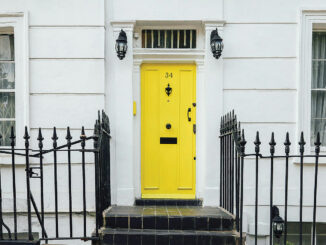
It’s the classic real estate story. Two people decide to buy a home together, but one loves Victorian architecture and the other one loves Mid-Century Modern. Each is playing a movie in their head of what their life will look like in a particular style house.
Common Ground
This lack of specificity can help both buyers find common ground. (Unless one is just so stubborn they refuse to compromise. Which likely leads to their buying a house alone.) A good Realtor understands this and starts to point out the features that appeal to each buyer. Let’s look at some popular home styles and point out what might be appealing to both the modern and old-fashioned buyer.
Colonial
Colonial-style homes are generally simple in design. The building is square or rectangular. The entry is placed in the middle. There are the same number and size of windows on either side of the door. Colonial-style homes are symmetrical. They often have decorative shutters on the sides of the windows. Some have porticos with columns. For the modern buyer, the simple lines and symmetry should be appealing. The lover of old-fashioned architecture will appreciate the home’s embellishments that convey its historical significance. That said, Colonial-style homes do not have the open floor plan many buyers prefer. But their simple lines can make it easier to open up the interior.
Victorian
There are actually several styles that are considered Victorian. The Victorian home most prevalent in America is the Queen Anne style. There is nothing symmetrical or subtle about a Queen Anne home. It has tall windows, a steeply pitched roof, a wrap-around porch, and highly ornate trim. The exterior is typically painted with a combination of several accent colors. A Victorian-style home is so contrary to modern aesthetic that only a short commute and great schools could make it appealing to that buyer.
Modern Minimalist
Modern Minimalist design brings the exterior and interior down to its essential components. It is focused on function, light, and space. The strategic use of materials comprises the decorative elements of the home. Modern Minimalist interiors employ the least number of walls possible. This can translate into a lack of privacy for some. It is what many would consider ultra-modern. It is the opposite of Victorian-style. You will be hard-pressed to convince an old-fashioned buyer to purchase a Modern Minimalist home.
Mid-Century Modern
Mid-Century Modern homes evoke the 1950s and 1960s. But the movement actually started in Germany in the 1920s. The flat lines of the building are adorned with a mix of steel, wood, and concrete. They have more warmth and are not as stark as a Modern Minimalist home. A neutral palette with pops of color is used in the interior design. The outdoor space becomes an extension of the indoor space. Mid-Century Modern style can be gussied up with color in the interior and exterior spaces. It offers the open floor plan usually preferred by both buyers.
Spanish Colonial
Spanish Colonial homes are typically found in warmer climates. The key features are stucco walls and red tile roofs. They often have enclosed courtyards and are one-story. The windows are small and sometimes have decorative iron gates. The front door is usually made of heavy, carved wood with metal accents. The subtle colors and integrated outdoor space can appeal to the modern buyer. The old-fashioned buyer will like its old-world feel.
Craftsman
A Craftsman style home has a covered porch, multi-paned windows, and a centered single dormer. A prominent feature of Craftsman style is a deeply overhanging roof and exposed rafter tails. The exterior colors are often earthy – greens and browns. The interior has built-in cabinets and shelving. The fireplace is usually a key feature of the living room. The floor plan is open, but the rooms are small. The Craftsman style can offer a compromise between the buyers. It has some historical touches that are not overwhelming. It can’t be called modern, but it has somewhat cleaner lines – especially compared to Victorian homes.
Making Any Style House a Home
From the start of the home search, each buyer should agree to at least consider different home styles. If they truly listen to one another, they can often find common ground. Other factors, such as location and schools, usually trump home style anyway. The truth is that unless you’re extraordinarily wealthy you probably won’t get the exact home of your dreams. Yet somehow most of us buy a home that is not at all the style we set out to purchase and turn it into something that we love.
It’s Personal
Buying your home is a critical life decision for most people. I believe in the unique, personal nature of real estate. I will carefully guide you through the process of buying your home – or any other real estate investment. Feel free to contact me anytime, whether it is to get started on helping you realize your goals and dreams, or just to ask a question. I would welcome the opportunity to make a difference for you. Please email me at pthessen1@gmail.com or call 270-796-7550.
-submitted by Perry Thessen




